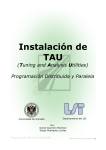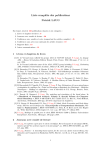Download The parallel JOSTLE library user guide : Version 3.0
Transcript
The parallel JOSTLE library user guide : Version 3.0 Chris Walshaw School of Computing & Mathematical Sciences, University of Greenwich, London, SE10 9LS, UK email: [email protected] July 8, 2002 Contents 1 The parallel JOSTLE library package 2 2 Calling pjostle from C 2 2.1 Compilation . . . . . . . . . . . . . . . . . . . . . . . . . . . . . . . . . . . . . . . . . . . . . . . . . . . . . . . . . . . . 2 2.2 Usage . . . . . . . . . . . . . . . . . . . . . . . . . . . . . . . . . . . . . . . . . . . . . . . . . . . . . . . . . . . . . . . . 2 2.3 Values of the graph variables . . . . . . . . . . . . . . . . . . . . . . . . . . . . . . . . . . . . . . . . . . . . . . . . . . . 3 2.4 Non-contiguous input data . . . . . . . . . . . . . . . . . . . . . . . . . . . . . . . . . . . . . . . . . . . . . . . . . . . . 5 2.5 Disconnected Graphs . . . . . . . . . . . . . . . . . . . . . . . . . . . . . . . . . . . . . . . . . . . . . . . . . . . . . . . 5 2.5.1 Isolated nodes . . . . . . . . . . . . . . . . . . . . . . . . . . . . . . . . . . . . . . . . . . . . . . . . . . . . . . . 5 2.5.2 Disconnected components . . . . . . . . . . . . . . . . . . . . . . . . . . . . . . . . . . . . . . . . . . . . . . . . 5 3 4 5 6 Customising the behaviour 6 3.1 Balance tolerance . . . . . . . . . . . . . . . . . . . . . . . . . . . . . . . . . . . . . . . . . . . . . . . . . . . . . . . . . 6 3.2 Dynamic (re)partitioning . . . . . . . . . . . . . . . . . . . . . . . . . . . . . . . . . . . . . . . . . . . . . . . . . . . . . 6 Additional functionality 7 4.1 Troubleshooting . . . . . . . . . . . . . . . . . . . . . . . . . . . . . . . . . . . . . . . . . . . . . . . . . . . . . . . . . . 7 4.2 Timing pjostle . . . . . . . . . . . . . . . . . . . . . . . . . . . . . . . . . . . . . . . . . . . . . . . . . . . . . . . . . . 7 4.3 Memory considerations . . . . . . . . . . . . . . . . . . . . . . . . . . . . . . . . . . . . . . . . . . . . . . . . . . . . . . 8 4.3.1 Memory requirements . . . . . . . . . . . . . . . . . . . . . . . . . . . . . . . . . . . . . . . . . . . . . . . . . . 8 4.3.2 Reusing application workspace . . . . . . . . . . . . . . . . . . . . . . . . . . . . . . . . . . . . . . . . . . . . . 8 4.4 Statistics functions . . . . . . . . . . . . . . . . . . . . . . . . . . . . . . . . . . . . . . . . . . . . . . . . . . . . . . . . . 8 4.5 Calling pjostle from FORTRAN . . . . . . . . . . . . . . . . . . . . . . . . . . . . . . . . . . . . . . . . . . . . . . . . 9 Advanced/experimental features 9 5.1 Heterogeneous processor networks . . . . . . . . . . . . . . . . . . . . . . . . . . . . . . . . . . . . . . . . . . . . . . . 9 5.2 Variable subdomain weights . . . . . . . . . . . . . . . . . . . . . . . . . . . . . . . . . . . . . . . . . . . . . . . . . . . 10 5.3 Empty subdomains . . . . . . . . . . . . . . . . . . . . . . . . . . . . . . . . . . . . . . . . . . . . . . . . . . . . . . . . 10 Algorithmic details and further information 11 1 The parallel JOSTLE library package The pjostle library package comprises this userguide and one or more library files compiled for different machines (e.g. libjostle.sgi.a) as requested on the licence agreement. It also includes a header file jostle.h containing C prototypes for all available jostle subroutines and jmpilib.c, an interface to the MPI communications library. Copies of the library are available for most UNIX based machines with an ANSI C compiler and the authors are usually able to supply others. 2 Calling pjostle from C 2.1 Compilation The library should be linked to the calling program as for any other library. However, the pjostle interface to MPI, jmpilib.c, is not part of the library but is supplied as source code and must be compiled separately by the user. For example to link with libjostle.sgi.a and assuming that MPIINCLUDE and MPILIB are environment variables stating where the MPI include files and library are installed, the compilation should include: cc -c -I$MPIINCLUDE jmpilib.c cc -o myprog myprog.o jmpilib.o -ljostle.sgi -lm -L$MPILIB -lmpi The -lm flag is necessary as pjostle uses the maths library. 2.2 Usage The declarations for pjostle functions are extern extern extern void void void jostle_env(char*); pjostle_init(int*,int*); pjostle(int*,int*,int*,int*,int*,int*,int*,int*, int*,int*,int*,int*,int*,int*,int*,double*); Before calling pjostle you must call MPI_Init (as for any other parallel MPI based program) and subsequently call pjostle_init(&nprocs, &pid); where nprocs is the number of processes and pid is the number of the calling process (0 ≤ pid < nprocs). pjostle_init should only be called once in a program and then pjostle may be called repeatedly. By default, pjostle uses the MPI communicator MPI_COMM_WORLD for group communications purposes, but to reset this call pjostle_comm(&comm); where comm is a valid MPI communicator (of type MPI_Comm) for the required group of processes. The call to pjostle is pjostle(&nnodes, &offset, &core, &halo, index, degree, node_wt, partition, &local_nedges, edges, edge_wt, &nparts, part_wt, &output_level, &dimension, coords); The variable nparts specifies how many parts (subdomains) the graph is to be divided up into. The array part_wt is only used for variable subdomain weights (see §5.2) and should be set to (int*) NULL if these are not being used. The variable output_level reflects how much output the code gives and can be set to 0, 1, 2 or 3 (0 is recommended). The variables nnodes, offset, nparts, part_wt, output_level and dimension should be set the same on every processor. Also currently nparts in the call to pjostle should be the same as nprocs in the call to pjostle_init. 2.3 Values of the graph variables Consider an example graph 1 4 3 2 6 7 5 and suppose that it is partitioned into two pieces 1 4 3 2 6 7 5 so that the two subdomains look like 1 0 4 3 2 2 6 7 4 3 6 7 1 5 For each processor, nodes are referred to as core nodes if the processor owns them or halo nodes if not. Thus processor 0 has core nodes 1, 2, 3 & 4 and halo nodes 6 & 7, while processor 1 has core nodes 5, 6 & 7 and halo nodes 2, 3 & 4. Note that every node in the graph must be a core node of one and only one processor. The values of the scalar quantities for processor 0 are then nnodes 7 there are 7 nodes in the whole graph offset 1 the index of the first node is 1 core 4 processor 0 owns 4 nodes (1,2,3,4) halo 2 processor 0 has 2 halo nodes (6,7) (although halo should be set to 0 for the contiguous format – see below) local_nedges 10 the sum of degrees of core nodes (i.e. the length of the edge array) is 10 dimension 0 not used – set to zero Note that offset should be set to 0 or 1 depending on whether the node numbering starts at 0 (as is common in C programs) or 1 (as is common in FORTRAN programs). There are then two possible formats to use when specifying the arrays to pjostle. The more general is the node based format where core & halo information (index, partition, degree and node_wt) is passed in for each node. A special case is the contiguous format which may be used if the initial partition of the graph is strictly contiguous, i.e. nodes 1, . . . , k1 on processor 0; nodes k1 + 1, . . . , k2 on processor 1; . . .; and nodes kP −1 + 1, . . . , N on processor P − 1. In this case the index array contains the number of core nodes in each subdomain, halo information does not need to be passed in for each node (in the arrays partition, degree and node_wt) and the variable halo should be set to 0. For the example graph using the node-based format, the lengths of the arrays index, partition, degree and node_wt should be core + halo. Alternatively for the contiguous format the length of index should be nparts and the lengths of the arrays partition, degree and node_wt should be core. For either format the lengths of the arrays edges and, if used, edge_wt should be local_nedges. For the node-based format the values of the arrays for processor 0 are index [1,2,3,4,6,7] indices of core nodes followed by indices of halo nodes partition [-,-,-,-,1,1] on entry, the last halo entries should contain the processor number of the halo nodes on exit, the first core entries contain the new processor number of the core nodes degree [2,3,4,1,4,4] degree of the nodes listed in index – e.g. the degree of node 6 is 4 even though processor 0 only knows about 2 of the edges node_wt (int*) NULL if all the nodes have weight 1; OR node_wt [1,1,4,1,1,1] if, for example, node 3 has weight 4 edges [2,3,1,3,7,1,2,6,7,6] numbers representing the neighbours of each core node (i.e. 1 is adjacent to {2,3}; 2 is adjacent to {1,3,7}; 3 is adjacent to {1,2,6,7}; 4 is adjacent to {6}) edge_wt (int*) NULL if all the edges have weight 1; OR edge_wt [1,1,1,3,1,1,3,1,1,1] if, for example, edge (2,3) has weight 3 (note that the weight is repeated – once in the position corresponding to node 2’s edge with 3 and again in the position corresponding node 3’s edge with 2) coords (double*) NULL not used For the contiguous format the values of the arrays for processor 0 are index [4,3] there are 4 core nodes on processor 0 and 3 on processor 1 partition [-,-,-,-] on exit, the entries contain the new processor number of the core nodes degree [2,3,4,1] degree of the core nodes node_wt (int*) NULL if all the nodes have weight 1; OR node_wt [1,1,4,1] if, for example, node 3 has weight 4 edges [2,3,1,3,7,1,2,6,7,6] numbers representing the neighbours of each core node (identical to node-based format – see above) edge_wt (int*) NULL if all the edges have weight 1; OR edge_wt [1,1,1,3,1,1,3,1,1,1] if, for example, edge (2,3) has weight 3 (identical to node-based format – see above) coords (double*) NULL not used The values of the scalar quantities for processor 1 are nnodes 7 offset 1 core 3 halo 3 local_nedges 10 dimension 0 For the node-based format the values of the arrays for processor 1 are index [5,6,7,2,3,4] partition [-,-,-,0,0,0] degree [2,4,4,3,4,1] node_wt (int*) NULL edges [6,7,3,4,5,7,2,3,5,6] edge_wt (int*) NULL coords (double*) NULL For the contiguous format the values of the arrays for processor 1 are index [4,3] partition [-,-,-] degree [2,4,4] node_wt (int*) NULL edges [6,7,3,4,5,7,2,3,5,6] edge_wt (int*) NULL coords (double*) NULL The node based format is the default and if the contiguous format is used, each call to pjostle must be preceded by a call jostle_env("format = contiguous"); 2.4 Non-contiguous input data To use graphs with non-contiguous sets of nodes, the missing nodes are regarded as nodes of zero weight and zero degree (i.e. not adjacent to any others). They should be left out of the input data, but the variable nnodes should refer to the total number of nodes including those of zero weight. Thus the index, i, of any node must lie within the range 0 ≤ i − offset < nnodes. 2.5 Disconnected Graphs Disconnected graphs (i.e. graphs that contain two or more components which are not connected by any edge) can adversely affect the partitioning problem by preventing the free flow of load between subdomains. In principle it is difficult to see why a disconnected graph would be used to represent a problem since the lack of connections between two parts of the domain implies that there are no data dependencies between the two parts and hence the problem could be split into two entirely disjoint problems. However, in practice disconnected graphs seem to occur reasonably frequently for various reasons and so facilities exist to deal with them in two ways. 2.5.1 Isolated nodes A special case of a disconnected graph is one in which the disconnectivity arises solely because of one or more isolated nodes or nodes which are not connected to any other nodes. These are handled automatically by pjostle. If desired they can be left out of the load-balancing by setting their weights to zero, but in either case, if not already partitioned, they are distributed to all subdomains on a cyclic basis. 2.5.2 Disconnected components If the disconnectivity arises because of disconnected parts of the domain which are not isolated nodes, then pjostle may detect that the graph is disconnected and abort with an error message or it may succeed in partitioning the graph but may not achieve a very good load-balance (the variation in behaviour depends on how much graph reduction is used). To check whether the graph is connected, use the graph checking facility (see §4.1). To partition a graph that is disconnected use the setting jostle_env("connect = on"); This finds all the components of the graph (ignoring isolated nodes which are dealt with separately) and connects them together with a chain of edges between nodes of minimal degree in each component. However, the user should be aware that (a) the process of connecting the graph adds to the partitioning time and (b) the additional edges are essentially arbitrary and may bear no relation to data dependencies in the mesh. With these in mind, therefore, it is much better for the user to connect the graph before calling pjostle (using knowledge of the underlying mesh not available to pjostle). Finally note that, although ideally these additional edges should be of zero weight, for complicated technical reasons this has not been implemented yet and so the additional edges have weight 1 (which may be included in the count of cut edges). 3 Customising the behaviour pjostle has a range of algorithms and modes of operations built in and it is easy to reset the default environment to tailor the performance to a users particular requirements. 3.1 Balance tolerance As an example, pjostle will try to create perfect load balance while optimising the partitions, but it is usually able to do a slightly better optimisation if a certain amount of imbalance tolerance is allowed. The balance factor is defined as B = Smax /Sopt where Smax is the weight of the largest subdomain and Sopt is the optimum subdomain size given by Sopt = dG/P e (where G is the total weight of nodes in the graph and P is the number of subdomains). The current default tolerance is B = 1.03 (or 3% imbalance). To reset this, to 1.05 say, call jostle_env("imbalance = 5"); before a call to pjostle. This call will only affect the following call to pjostle and any subsequent calls will not be affected. Note that for various technical reasons pjostle will not guarantee to give a partition which falls within this balance tolerance (particularly if the original graph has weighted nodes in which case it may be impossible). 3.2 Dynamic (re)partitioning Using pjostle for dynamic repartitioning, for example on a series of adaptive meshes, can considerably ease the partitioning problem because it is a reasonable assumption that the initial partitions at each repartition may already be of a high quality. One optimisation possibility then is to increase the coarsening/reduction threshold – the level at which graph coarsening ceases. This should have two main effects; the first is that it should speed up the partitioning and the second is that since coarsening gives a more global perspective to the partitioning, it should reduce ‘globality’ of the repartitioning and hence reduce the amount of data that needs to be migrated at each repartition (e.g. see [3]). Currently the code authors use a threshold of 20 nodes per processor which is set with jostle_env("threshold = 20"); However, this parameter should be tuned to suit particular applications. A second possibility, which speeds up the coarsening and reduces the amount of data migration is to only allow nodes to match with local neighbours (rather than those in other subdomains), and this can be set with jostle_env("matching = local"); However, this option should only be used if the existing partition is of reasonably high quality. For a really fast optimisation, without graph coarsening use jostle_env("reduction = off"); which should also result in a minimum of data migration. However, it may also result in a deterioration of partition quality, and this will be very dependent on the quality of both the initial partition and also how much the mesh changes at each remesh. Therefore, for a long series of meshes it may be worth calling pjostle with default settings every 10 remeshes or so to return to a high quality partition. Finally note that some results for different pjostle configurations are given in [8]. The configuration JOSTLE-MS is not strictly available with pjostle as this uses serial optimisation. However calling pjostle with the default behaviour is the closest parallel version. The settings to achieve similar behaviour as the other configurations are Configuration JOSTLE-D JOSTLE-MD JOSTLE-MS 4 4.1 Setting reduction = off threshold = 20, matching = local – Additional functionality Troubleshooting pjostle has a facility for checking the input data to establish that the graph is correct, that halo data & interprocessor edges match up and that the graph is connected. If pjostle crashes or hangs, the first test to make, therefore, is to switch it on with the setting jostle_env("check = on"); or jostle_env("check = limited"); Note that full checking requires O(N ) memory (where N is the number of nodes in the graph) and so if this is not possible limited checking should be used. The checking process takes a fair amount of time however, and once the call to pjostle is set up correctly it should be avoided. If the graph is incorrect or inconsistent, pjostle will abort with an error message. Unfortunately if several processes abort at once their error messages all get written to stderr and may all appear at once giving confusing output. However, the error messages are also written to the files pjostle.pid.log, where pid is the identification number of the process. Note that, if after checking, the graph still causes errors it may be necessary to send the input to the authors of pjostle for debugging. In this case, pjostle should be called with the setting jostle_env("write = input"); Each process pid will then generate a subdomain file, pjostle.nparts.pid.sdm, containing the input it has been given, and this data should be passed on to the pjostle authors. 4.2 Timing pjostle The code contains its own internal stopwatch which can be used to time the length of a run. It calls a barrier synchronisation immediately before the start and end of timing. The timing routine used is MPI_Wtime which is elapsed (or wall clock) time. Note that for optimal timings the graph checking (§4.1) should not be switched on. By default the output goes to stderr but this can be changed with the setting jostle_env("timer = stdout"); to switch it to stdout, or jostle_env("timer = off"); to switch it off entirely. Note that switching it off also switches off the barrier synchronisations and should be employed when using external timers around the call to pjostle. 4.3 4.3.1 Memory considerations Memory requirements The memory requirements of pjostle are difficult to estimate exactly (because of the graph coarsening and halo sizes) but will depend on N (the total number of graph nodes) and E (the total number of graph edges). In general, if using graph coarsening, at each coarsening level N is approximately reduced by a factor of 1/2 and E is reduced by a factor of approximately 2/3. Thus the total storage required is approximately 2N + 3E. For pjostle this total can be divided by P – the number of processors, but must be increased to allow for the sizes of the halos and the fact that the internal graph may become slightly unbalanced during the load-balancing. A factor of 2 is perhaps excessive for large grained problems but gives a good safety margin. Thus the storage requirements are approximately (4N + 6E)/P if using graph coarsening and (2N + 2E)/P if not. The memory requirement for each node is 3 pointers, 3 int’s and 6 short’s and for each edge is 2 pointers and 2 int’s. On 32-bit architectures (where a pointer and an int requires 4 bytes and a short requires 2 bytes) this gives 36 bytes per node and 16 bytes per edge. On architectures which use 64 bit arithmetic, such as the Cray T3E, these requirements are doubled. Thus the storage requirements (in bytes) for pjostle are approximately: graph coarsening on graph coarsening off 4.3.2 32-bit (144N + 96E)/P (72N + 32E)/P 64-bit (288N + 192E)/P (144N + 64E)/P Reusing application workspace To save memory, pjostle has a facility for using a workspace allocated externally by the application (whether permanently allocated in FORTRAN as an array declaration, e.g. integer workspace(10000), or dynamically allocated in C using malloc). To make use of this facility, call jostle_wrkspc_input(&length, workspace); before every call to pjostle where workspace is the address of the workspace (cast as a char*) and length is its length in bytes. Note that the workspace need not be a type char array and only needs to be cast this way to fit with the function prototypes in jostle.h. Should this workspace prove insufficient for its memory requirements, pjostle will use as much of it as possible until it runs out and subsequently allocate additional memory using malloc. 4.4 Statistics functions A number of subroutines are available to return statistics about the partition calculated by pjostle and about the partitioning process. They are as follows: int jostle_cut(); The int function jostle_cut returns the total weight of cut edges. double jostle_bal(); The double function jostle_bal returns the balance expressed as a ratio of the maximum subdomain weight over the optimal subdomain weight (as defined in Section 3.1), i.e. a return value of 1.00 is perfect balance. double jostle_tim(); The double function jostle_tim returns the run time in seconds of pjostle. int jostle_mem(); The int function jostle_mem returns the memory used by pjostle (in bytes). Note that this is the memory used on the processor from which the call is made, not a global maximum or sum of usage. 4.5 Calling pjostle from FORTRAN Almost everything described in this document will work the same way when calling pjostle from FORTRAN rather than C. Thus the call to pjostle is + + + + call pjostle(nnodes, offset, core, halo, index, degree, node_wt, partition, local_nedges, edges, edge_wt, network, part_wt, output_level, dimension, coords) where nnodes, offset, core, halo, local_nedges, output_level & dimension are integer variables, index, degree, node_wt, partition, edges, edge_wt, network & part_wt are integer arrays and coords is a double precision array. Note that for arrays which can be set to NULL when called from C (e.g. if all the nodes have weight 1, the array node_wt can be set to NULL), the same effect can be achieved by passing in a single variable set to −1). Also since coords is never used it can be a single variable rather than an array. In other words, if node_wt, edge_wt & part_wt are not being used, the following piece of code will work: + + + + double precision dummy_coords integer idummy, dimension idummy = -1 dimension = 0 call pjostle_init(nprocs, pid) call pjostle(nnodes, offset, core, halo, index, degree, idummy, partition, local_nedges, edges, idummy, network, idummy, output_level, dimension, dummy_coords) To use the jostle_env calls, just replace the double quotation marks in the string with single ones, e.g.: call jostle_env(’check = on’) 5 5.1 Advanced/experimental features Heterogeneous processor networks pjostle can be used to map graphs onto heterogeneous processor networks in two ways (which may also be combined). Firstly, if the processors have different speeds, pjostle can give variable vertex weightings to different subdomains by using processor weights – see §5.2 for details. For heterogeneous communications links (e.g. such as SMP clusters consisting of multiprocessor compute nodes with very fast intra-node cmmmunications but relatively slow inter-node networks) a weighted complete graph representing the communications network can be passed to pjostle. For an arbitrary network of P processors numbered from 0, . . . , P − 1, let lp:q be the relative cost of a communication between processor p and processor q. It is assumed that these cost are symmetric (i.e. lp:q = lq:p ) and that the cost expresses, in some averaged sense, both the latency and bandwidth penalties of such a communication. For example, for a cluster of compute nodes lp:q might be set to 1 for all intra-node communications and 10 for all inter-node communications. To pass the information into pjostle the nparts variable is replaced with an array, network say (since all scalar variables are passed in as pointers this causes no problems). The network array should then be set to network[0] = −1 network[1] = P network[2, . . . , P (P − 1)/2 + 1] = l0:1 , l0:2 , l1:2 , ..., ..., ..., l0:P −1 , l1:P −1 , lP −2:P −1 The −1 signifies that it is an arbitrary network and P then gives the number of processors. The following P (P − 1)/2 entries are the upper triangular part of the network cost matrix (e.g. see [6, Fig. 2]). The choice of the network cost matrix coefficients is not straightforward and is discussed in [6]. This functionality is available in parallel but pjostle actually solves the mapping/partitioning problem in serial (invisibly from the user). 5.2 Variable subdomain weights It is sometimes useful to partition the graph into differently weighted parts and this is done by giving the required subdomains an additional fixed weight which is taken into account when balancing. For example suppose pjostle is being used to balance a graph of 60 nodes in 3 subdomains. If subdomain 1 were given an additional fixed weight of 10 say and subdomain 2 were given an additional fixed weight of 20, then the total weight is 90 (= 60 + 10 + 20) and so pjostle would attempt to give a weight of 30 to each subdomain and thus 30 nodes to subdomain 0, 20 nodes to subdomain 1 and 10 nodes to subdomain 2. These weights can be specified to pjostle using the part_wt argument. Thus in the example above pjostle should be called with part_wt set to [0,10,20]. Note that this array should be the same on every processor. Often it is more useful to think about the additional weights as a proportion of the total and in this case a simple formula can be used. For example, suppose a partition is required where Q of the P subdomains have f times the optimal subdomain weight Sopt (where 0 ≤ f ≤ 1). Suppose that the total weight of the graph is W so that the optimal subdomain weight without any additional fixed weight is Sopt = W/P . Now let W 0 represent the new total 0 represent the new optimal subdomain weight. The graph weight (including the additional fixed weights) and let Sopt 0 0 can be calculated from: additional fixed weight must be (1 − f ) × Sopt in each of the Q subdomains and so Sopt 0 Sopt = 0 W + Q(1 − f )Sopt W0 = P P and hence 0 Sopt = W P − Q(1 − f ) Thus the additional fixed weight on each of the Q subdomains should be set to 0 (1 − f ) × Sopt = (1 − f ) × W P − Q(1 − f ) Thus if, say, P = 5, Q = 3, W = 900 and f = 1/3 (i.e. three of the five subdomains have one third the weight of the other two) then W 900 0 Sopt = = = 300 P − Q(1 − f ) 5 − 3(2/3) and so the additional fixed weight is 0 (1 − f ) × Sopt = 2/3 × 300 = 200 and the part_wt array would be set to [0,0,200,200,200]. 5.3 Empty subdomains It is possible for one or more processors to start the partitioning process empty (i.e. owning no nodes) and, assuming that they have not been designated as idle (as above §5.2) and that the balancing succeeds, then a fair share of the load should be distributed to them by pjostle. Typically the subdomains will be seeded with a single node at the top of the graph contraction process and then the optimisation should ensure load-balance. In this way pjostle can even be used before the graph has been distributed (i.e. if one processor owns the entire graph). Alternatively, if all but one of the subdomains are empty, a more efficient usage of memory is for pjostle to distribute the data (using a contiguous block based distribution) before starting partitioning. In this case all processors must call jostle_env("scatter = on"); before calling pjostle and processor 0 should pass in the entire graph (using the node based format described in section 2.3, although with the index array set to (int*) NULL) whilst all the other processors should have core, halo and local_nedges set to zero. 6 Algorithmic details and further information pjostle uses a multilevel refinement and balancing strategy, [4], i.e. a series of increasingly coarser graphs are constructed, an initial partition calculated on the coarsest graph and the partition is then repeatedly extended to the next coarsest graph and refined and balanced there. The refinement algorithm is a parallel iterative optimisation algorithm which uses the concept of relative gain and which incorporates a balancing flow, [5]. The balancing flow is calculated either with a diffusive type algorithm, [1] or with an intuitive asynchronous algorithm, [2]. pjostle can be used to dynamically repartition a changing series of meshes both load-balancing and attempting to minimise the amount of data movement and hence redistribution costs. Sample recent results can be found in [4, 5, 8]. The modifications required to map graphs onto heterogeneous communications networks (see §5.1) are described in [6]. pjostle also has a range of experimental algorithms and modes of operations built in such as optimising subdomain aspect ratio (subdomain shape), [7]. Whilst these features are not described here, the authors are happy to collaborate with users to exploit such additional functionality. Further information may be obtained from the JOSTLE home page: http://www.gre.ac.uk/jostle and a list of relevant papers may be found at http://www.gre.ac.uk/˜c.walshaw/papers/ Please let us know about any interesting results obtained by pjostle, particularly any published work. Also mail any comments (favourable or otherwise), suggestions or bug reports to [email protected]. References [1] Y. F. Hu, R. J. Blake, and D. R. Emerson. An optimal migration algorithm for dynamic load balancing. Concurrency: Practice & Experience, 10(6):467–483, 1998. [2] J. Song. A partially asynchronous and iterative algorithm for distributed load balancing. Parallel Comput., 20(6):853– 868, 1994. [3] C. Walshaw and M. Cross. Load-balancing for parallel adaptive unstructured meshes. In M. Cross et al., editor, Proc. Numerical Grid Generation in Computational Field Simulations, pages 781–790. ISGG, Mississippi, 1998. [4] C. Walshaw and M. Cross. Mesh Partitioning: a Multilevel Balancing and Refinement Algorithm. SIAM J. Sci. Comput., 22(1):63–80, 2000. (originally published as Univ. Greenwich Tech. Rep. 98/IM/35). [5] C. Walshaw and M. Cross. Parallel Optimisation Algorithms for Multilevel Mesh Partitioning. Parallel Comput., 26(12):1635–1660, 2000. (originally published as Univ. Greenwich Tech. Rep. 99/IM/44). [6] C. Walshaw and M. Cross. Multilevel Mesh Partitioning for Heterogeneous Communication Networks. Future Generation Comput. Syst., 17(5):601–623, 2001. (originally published as Univ. Greenwich Tech. Rep. 00/IM/57). [7] C. Walshaw, M. Cross, R. Diekmann, and F. Schlimbach. Multilevel Mesh Partitioning for Optimising Domain Shape. Intl. J. High Performance Comput. Appl., 13(4):334–353, 1999. (originally published as Univ. Greenwich Tech. Rep. 98/IM/38). [8] C. Walshaw, M. Cross, and M. G. Everett. Parallel Dynamic Graph Partitioning for Adaptive Unstructured Meshes. J. Parallel Distrib. Comput., 47(2):102–108, 1997. (originally published as Univ. Greenwich Tech. Rep. 97/IM/20).
















![Page 1 (12) United States Patent Castaldi et a]. US007118220B2](http://vs1.manualzilla.com/store/data/005861806_1-939e513e2a7d3e1f9213dbaf59950ac6-150x150.png)





